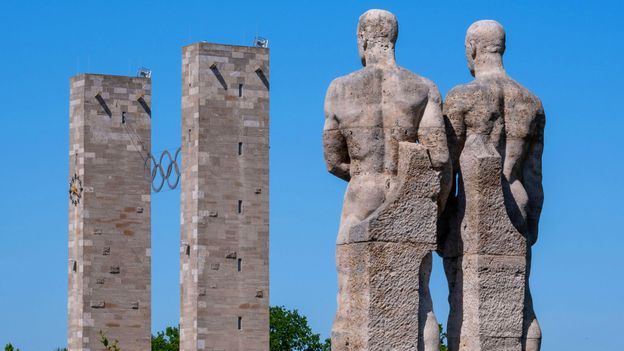In Italy, the EUR district in Rome was conceived by Mussolini as an architectural celebration of fascism. Wandering its eerie landscape, you come across the Palazzo della Civiltà Italiana, whose façade is emblazoned with a quotation taken from Mussolini’s speech announcing the invasion of Ethiopia. Just north of Rome’s city centre lies the Foro Italico sports complex, whose entrance features a 17.5m-tall obelisk with the words MUSSOLINI DUX carved into it. Inside the Foro Italico hangs The Apotheosis of Fascism, a painting depicting Mussolini as a kind of God-Emperor. It was covered up by the Allies in 1944 for being too grotesque, and then uncovered by the Italian government in 1996.
(Commentary)
Rather than destroying these works—a solution that the lower classes had no problem with back in the 1940s—the white moderates predictably offered a false compromise:
In the end, a creative solution was found, one that managed to unite the city and defuse the tension between the two communities. The solution was to “recontextualise” the monuments, maintaining their artistic integrity and historical importance, while simultaneously neutralising and subverting their fascist rhetoric.
[…]
First up the Victory Monument, which elicited strong emotions on both sides. […] The artists decided to emblazon the Hannah Arendt quote “Nobody has the right to obey” across the frieze in German, Italian and Ladin – the region’s three official languages. The quote is even more subversive when you remember that the building currently houses the city’s tax office.
Your solution to an antisocialist’s monument was to plaster another antisocialist’s generic, wishy‐washy, feel‐good quote on it…? Gee, thanks. I’m sure that she would have appreciated it.
Further reading:
Why Are So Many Fascist Monuments Still Standing in Italy?
(Quote)
[…] the Allied Control Commission’s bulletins and reports instead recommended that only the most obvious and “unaesthetic” monuments and decorations, like busts of Mussolini, be destroyed; the rest could be moved to museums, or simply be covered up with cloth and plywood.
Row over fascist-era statue reveals schism in how Italians deal with past



(Source.)
That Yamagata who waged war against literally everyone he could get his hands on using everything from samurai sword in the time of samurai up to battleships and planes and who sat at some point at basically every military and government office even slightly related to war and imperialism? In history of Japan not even Toyotomi Hideyoshi was so bloodthirsty and they don’t feel he’s “inappropriate for the “New Japan,” a peaceful and cultured state whose military had been abolished”?
Lmao